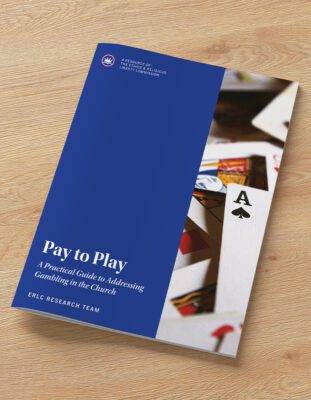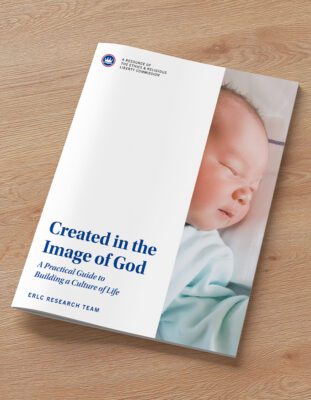There has been much written lately about the declining rates of childbearing. Some argue that it is a good choice in light of economic and climate concerns, while others worry about the fact that men and women are delaying marriage and childbirth until later in life, leading to a population decline. Nowhere is this more acute than in Japan where a city of some two dozen adults have resorted to lifelike dolls as stand-ins for people because the last child born in the city was over 20 years ago. The recent COVID-19 epidemic has even contributed to what has been called a “baby bust” in the United States. This decline in births has serious implications for all areas of life, including religion.
In his new book, Faith and Fertility: The Demographic Revolution and the Transformation of World Religions, Baylor historian Philip Jenkins looks at the close connections between rates of fertility and religious adherence across the globe. His book explores the relationship between childbearing and secularization and the current ways that the religious landscape of the world is being reshaped, especially in Western Europe and North America where fertility rates have fallen precipitously in recent decades.
In your introduction, you say that there is a direct relationship between the fertility rates of a society and its religiosity. Countries with high fertility rates also (typically) enjoy higher rates of religiosity, and vice versa. Is one feeding the other, or are these just predictors of the future?
Anyone who ever took a college course on sociology knows about debates over causation and correlation. If two things happen at the same time, does one cause the other, or are they both caused by something else altogether? Or, are they simply unconnected? What I am saying is that if you look at particular countries, or regions, that linkage between fertility rates and religiosity is very strong indeed. Moreover, sudden changes in the one trend correspond really neatly to changes in the other. In fact, as I argue, you can actually use fertility changes as a predictor of what will happen in the religiosity of a particular society, and those predictions are very likely to hold good. So is this causation or correlation?
One problem is that the two trends happen in such short time periods — maybe five or 10 years — that it is close to impossible to decide which is cause and which effect. I think for instance of a country like Italy in the 1970s, which quite suddenly in just a few years experienced a very sharp fertility drop, and where in those same years, religious practice and commitment plunged. I can actually make a good case either way, for which trend is causing which. But in a sense, that does not really matter, because the basic linkage is so solid, and attested so widely. What we can say with high confidence is that high fertility societies are also high faith, and vice versa. When a high fertility society suddenly moves to a low fertility model — and those changes do tend to be sudden — then watch closely for the religious effects.
How do the changes in fertility and focus on child-centered families change other attitudes in the society? What are some areas of rapid shifts in public attitude that have coincided with the shift in fertility and religiosity?
I use the example of Europe from the 1960s onward, although the changes that happened there have subsequently moved over much of the globe. When family size declines, and children are less on the scene, several things happen. Quite rapidly, people lose many of the ties that previously bound them to churches or other religious institutions. They are no longer sending children to church schools or first communion classes or bar mitzvah classes. But also, society becomes more open to arguments that separate sexuality from reproduction. In the older world, families might have listened closely to what religious institutions said about enforcing sexual morality through law, but that changes quickly. In Europe, so many of these changes have happened through referenda and public votes, rather than, as in the U.S., through judicial decisions. So, you can actually map quite revolutionary changes in public attitudes, with a new openness to contraception, divorce, abortion, and gay rights issues.
As a result, countries that in 1960 were some of the world’s most morally conservative became some of the most liberal. At every stage, you can also link these developments to changes in fertility. As society becomes more liberal or even radical on these issues, so the churches lose ever more support as they are repeatedly depicted as the bad guys seeking to staunch progress. They face a kind of vicious circle. People are prepared to accept or tolerate the churches and clergy but only as long as they keep out of private lives. In terms of how religion has always been seen as a force in public life, that is a revolutionary development.
It is not, you argue, necessarily Marx or Freud whose work has reduced the appeal of religion, but possibly the work of Louis Pasteur and advances in medicine. Why has something like germ theory shifted our understanding of the family?
One great force driving high fertility in past centuries was the very high death rate for babies and small children. Infant mortality rates were inconceivably dreadful, so people had to have lots of children to compensate for losses. That in turn severely constrained women’s lives. New insights about germs and infections meant that infant mortality rates fell incredibly fast, and that was the essential precondition for smaller family size. At the same time, knowing the causes of disease has massively reduced the role of clergy and churches in seeking to offer healing and protection against bodily ills. Whole areas of life have been transferred to the medical profession, which now can have a real and positive impact, which was certainly not true until the mid-19th century.
Also, higher standards of health mean that death has become a less familiar and visible part of our everyday lives, and that in turn has limited what was once one of the critical functions of clergy, namely in being present at deathbeds and funerals. Today, death is more medicalized, and is regarded as something for the very old, rather than something that can strike anyone at any time. We have had a revolution in death.
Your book deals a lot with secularization theory and the idea that religion will just generally decline and eventually disappear. However, you say that secularization is a self-limiting process. What do you mean by this?
Imagine a society that is low faith and low fertility, and as I say, the two trends go together. Societies age and become more stable. They also become more secular, and more liberal in their cultural and sexual attitudes. If those are your views, you might think that is a wonderful prospect, and we are all joining together singing John Lennon’s Imagine. But a society with a median age in the 40s — and that is much of Europe today — simply cannot survive economically. It needs people to do the working class jobs, to provide the human services, and to pay the taxes. That means drawing in immigrants, who come from young and high fertility lands in the Global South. In Western Europe, that means turning to North Africa or the Middle East, or South Asia.
But high fertility societies are also high faith societies, and those new immigrants are likely to be strongly religious, not to mention very traditional in their morality. Many immigrants are Muslim, but plenty of others are passionately Christian. So, in that sense, a secular society will inevitably be transformed by those strictly non-secular immigrants. Over time, the immigrants will often come close to outnumbering the old-stock populations. The less religious a society is today, the more religious it will become in a generation or so.
While the secularization that you note about Europe is true, America has traditionally been a sort of outlier to the conversation because it resembles European nations in many respects but has also retained high levels of religious behavior and identity. Will that trend continue or will American begin to look more like Europe in the near future?
The U.S. was long a problem for scholars of religion, because it was high faith and (relatively) high fertility. Some of us — including myself! — spent lots of time trying to account for this paradox. For better or worse, we no longer have to explain such things because the U.S. has now moved decisively to European levels of fertility. The big change was the economic crisis of 2007-8, which increasingly looks like a social revolution in people’s ways of life and expectations.
Today, U.S. fertility rates track closely with those of famously low-fertility Denmark, and they may well go lower: it will be very interesting to see the long-term impact of the pandemic. And as we might have expected, low fertility rapidly implies low faith. The best evidence for this is the dramatic growth of the Nones, those who reject any religious affiliation. They already outnumber Catholics, and by 2025 should be the largest component of the U.S. population, above evangelicals.
Ronald Inglehart wrote recently that “Since 2007, the United States has showed the largest shift of any country away from religion and now ranks among the world’s least religious publics.” For anyone who recalls conditions even a decade ago, that’s amazing. So yes, I do think that “Europe awaits.”
This decline in religion though is not a complete rejection of faith. There is an increase as you note in pilgrimages to holy sites and even many of the Nones (as Ryan Burge has argued in his book on the growing religious group) display some continued adherence to religious belief. So, is this part of the larger conversation about a declining trust in institutions across culture, not just the church specifically?
And that is an excellent point. When people talk about secularization, they often see it as the same as atheism, which it is not. When people cut loose from institutions, they often maintain the underlying codes and belief system, as in the case of the Nones. But here is the problem. If you cast off moorings from any and all churches, and live what you see as a religious life free of institutions, how long can you keep that up? Decades? A generation? And more important, is that something that can be passed on to the next generation. In Europe, it took a few decades, but those Nones gradually did turn into actual atheists, who see no reason at all for the survival of religion. I am not saying that trajectory is inevitable, but it seems like one we should be aware of.
How does the question of mass migration and immigrations contribute to this discussion? What effect does an influx of immigrants have on the religious behavior and fertility rates of a country? How do immigrants change over time in terms of childbirth and religious behavior?
Right, I mentioned this earlier. Immigrants do tend to be younger than the historic population, because they are the sort of people who are likely to make such a dramatic move, and early on at least, they are very religious. As to what happens over two or three generations, that is a different matter. Certainly, people of migrant stock tend to move toward the norms of the host society, and their fertility rates do drop. Religion is a more complex matter. Christian migrants are a major part of church life in Europe, especially in countries like Britain, and we see a very similar pattern here in the U.S.
Muslims might tend to keep their religion even longer because it is so intimately bound up with every aspect of their lives, and their social realities. It is actually a very major and difficult step to move to be a real “ex-Muslim,” even if you abandon many aspects of the belief system.
In looking at Africa, you note that soon it will demographically lay claim to the title of the most populous Christian continent. What changes can expect to arise from this shift from Western Europe and North America to the Global South, and particularly Africa?
Some areas of the world resist the drift to low fertility: Africa, and large portions of the Middle East and South Asia. These will increasingly dominate their respective faiths. By 2050 or so, around a third of all Christians will live on the African continent, and that does not include people of African stock living elsewhere in the world. The impact on Islam will be a bit less, because Muslim numbers are holding up very well in South Asia, but the African share will certainly grow for them too.
Common wisdom has often held that individuals go through stages of religiosity over the course of their lifetimes where they may leave in their young adult years but return when they have children. How does the shift in fertility affect that concept of the faith life cycle of individuals and their possibility of returning? How does it change the way that churches need to approach ministry and outreach in the future?
I think about all the effort that churches put into studying and catering for children and young people, and I wonder if we are asking the wrong questions. The demographic revolution sweeping the world right now has its greatest impact on the numbers of the old and very old. Those numbers are soaring, both in absolute and relative terms. How do churches cope with them, apart from just holding helpful seminars on dying, death, and estate planning? That aging, that “graying,” poses questions that most churches have scarcely begun to contemplate. Those are some of the greatest challenges to ministry and outreach, and we scarcely have the vocabulary as yet with which to approach the problem.










